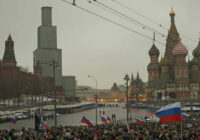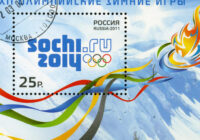The Sochi Winter Olympics is Putin’s personal project.
*[Note: The following is a translated report written by Russian opposition leader Boris Nemtsov and solidarity activist Leonid Martynyuk, detailing allegations of rampant corruption in the preparations for the 2014 Sochi Winter Olympics. This is an abridged version; the full report can be found in The Interpreter.]
Russia is a winter country. It’s hard to find a place on the map of Russia where snow hasn’t fallen or where winter sports haven’t been developed. However, Russian President Vladimir Putin found such a spot and decided to hold the winter Olympics there — in the city of Sochi.
Disgrace, Not Triumph
Prior to Russia’s application for the Olympics, many citizens were certain that the event would be held in the mountainous regions of Sochi, in the gorges, and on the slopes of Krasnaya Polyana. Many people thought the Olympics would result in increased prestige for Russia worldwide, the development of winter sports, and the creation of a world-class ski resort — the only one in the country
That is why, immediately after the International Olympics Committee made its decision in July 2007 in Guatemala, millions of Russian citizens rejoiced at the result.
However, the joy was short-lived. It turned out that the main competitions, both the opening and closing ceremonies of the games, would take place at the Imeret Lowlands: a sub-tropical swamp located on the shore of the Black Sea in the basin of the Mzymta River – the warmest place not only in Sochi, but in the whole of Russia. Russian authorities explained this was due to limited space for the stadiums and the main Olympic Village in the mountains.
Putin’s personal trip to Guatemala and his assurances that the Olympic facilities would be completed on time, and that enormous sums – $12 billion – would be spent on preparation, played a large role in the success of the Russian bid.
As it has now become clear, the Russian Olympics budget beat all the world records and now consists of more than $50 billion.
The Winter Olympics in Sochi is Putin’s personal project. He believed (and likely still believes) the Olympic Games would be his triumph, and that the participation of athletes from around the world would be seen as recognition of his indisputable leadership, both in Russia and beyond.
Subsequent events have demonstrated that the preparation for the Olympics has become a disgrace rather than a triumph. It has become increasingly clear that the Sochi Olympics are an unprecedented thieves’ caper in which representatives of Putin’s government are mixed up along with oligarchs. This caper is not even comparable to Nikita Khrushchev’s reckless scheme to plant corn in the Russian Arctic, or the Communist plans to turn the course of the northern rivers.
Essentially, the Olympics have exposed, in concentrated form, the main flaws of the system: abuse, corruption, petty tyranny, cronyism, non-professionalism, and irresponsibility.
Abuse and Corruption
The Sochi Olympics has gone down in history before it has opened: It is the most expensive Olympics in the history of humankind. With over $50 billion already spent, it is more expensive than the sports infrastructure of all the other winter Olympics combined. Furthermore, the lion’s share of the funds are government expenditures (the state budget, loans from state banks, and state guarantees).
Even the most costly Olympics — the 2008 summer games in Beijing — was cheaper than the Sochi Olympics. The Beijing Olympics cost the Chinese $43 billion, according to official figures.
It is no secret that the preparation for the Olympics in Russia has been accompanied by unprecedented corruption. Below, we provide calculations for the scale of the embezzlement made through two different methods.
Growing Expense
In the summer of 2007 in Guatemala, President Putin announced during a meeting of the International Olympics Committee that the overall expenses for the Sochi Olympics would be $12 billion. At the time, this astronomical figure shocked the imagination of many of those present, as well as specialists. Essentially, Putin openly announced that he was prepared to spend twice as much on the Olympics than his competitors: the Austrians and South Koreans.
As we now know, the final figure for the expenditures – $50 billion – is four times the sum originally cited by Putin.
Generally, Olympic facilities have doubled in price as they have been built over the years. Winter Olympics have increased less in expense as opposed to summer Olympics.
The total expenditures on the last Winter Olympics in Vancouver approximately doubled from $2.88 billion to $6 billion. From this we can take away an important conclusion: the doubling in costs for the Winter Olympics which we see in Sochi is an anomaly that can be explained by banal thievery, corruption, embezzlement, and a complete lack of professionalism of the contractors.
The cost of the Olympics in Sochi, given the average world parameters for the increase in costs, should have been $24 billion (the $12 billion announced by Putin, multiplied by two). The remainder — $26 billion — consists of embezzlement and kickbacks.
Cost Analysis
Fisht, the chief Olympic stadium, is located in the Imeret Lowlands. The opening and closing ceremonies for the Olympic Games will take place there in February 2014. The stadium holds 40,000 fans. Originally, the cost of construction for the stadium was estimated at 7.5 billion rubles ($230 million). However, the cost is now claimed to be 23.5 billion ($780 million) — it has tripled. Thus, the cost per fan at the central stadium in Sochi is $19,500.
Let us compare this figure with the expenditures per fan at other Olympic stadiums. The average cost per fan at the Central Stadium of Olympics is about $6,000, while the average cost per fan at Putin’s stadium is triple the amount.
The Bolshoi Ice Palace (for hockey) holds 12,000 people and is also being built on the Imeret Lowlands. The original cost was estimated at $200 million. By 2012, it had risen to $300 million. The average cost per fan was $25,000. The rough cost of an analogous ice rink per fan in previous Olympics was $11,000. Thus, Putin’s hockey stadium is more than twice as expensive as the average stadium anywhere else in the world.
Putin’s Iceberg figure-skating palace is also 2.3 times the world average at $23,000 per fan. The Russian Hills ski jumps were $36,000 per fan, although the world average was $3,400 — nearly ten-times more. The Olympic Village built by Deripaska costs $363,000 per person; the average for other countries was $150,000, making Putin’s Olympics more than twice the world standard.
On the whole, for all the buildings, Putin’s cost has been double or triple the world average. Thus, by dividing the total cost of $50 billion by 2.5, the figure of $20 billion for the actual cost is yielded, with approximately $30 billion estimated for the amount of stolen funds.
Therefore, the total scale of embezzlement is approximately $25-30 billion, or about 50-60% of the stated final cost of the Russian Olympics.
This is the minimum amount of inflation one can expect from a system blighted by kickbacks. We have not taken into account, after all, that the slave labor of migrant workers was exploited in the Olympics. We haven’t factored in that the quality of the work cannot be compared with construction in Vancouver, Turin or Salt Lake City.
The scale of graft in the Olympic budgets defies the imagination. But this is where it gets interesting: not a single criminal case of fraud, embezzlement, bribe-taking or kickbacks has reached the courts. The main reason for the epic thievery in Putin’s Olympics is the closed nature of the Russian government and the impunity of criminals close to the president. That is an indictment of the system.
The Kings of Olympic Contracts
The astronomical sum of 1.5 trillion rubles spent on the Olympics has been controlled largely by business people and companies close to the Russian president.
The government has tried to promote the myth that the construction of the Olympic facilities is being done through private investment. This is absolutely not the case. The lion’s share of the construction is either being carried out at the expense of the state budget, through state corporations, or via shareholder associations which are state property or under state control.
There are only two large private investors: businessmen Oleg Deripaska and Vladimir Potanin.
The rule with regard to private investments has been that 70% of the capital invested has to be covered by loans from Vneshekonombank (a state corporation) and 30% by private contributions.
However, by the end of 2012, the Russian government admitted that practically all the Olympic buildings, without exception, were running at a loss and would never pay for themselves. As Vneshekonombank cautiously put it: “The investors began to view more critically the market risks for realization of the projects. The question of return on investment arose.” As a result, bank loans were increased by 90%.
In November 2013, Gazprom, Sberbank, Potanin and Deripaska demanded 100% guarantees from the government on loans for Olympic construction. The reason: All the buildings were constructed at a loss.
Thus, if you make the necessary calculations, it turns out that the overall amount of state capital investment in the program for preparation of the games is 96%. The Olympics are being built at the taxpayers’ expense.
Troika of Champions
The largest investor in the construction of the Olympic facilities is the state corporation Olimpstroy, which controls 303.9 billion rubles ($9.4 billion) of state budget funds. Originally, the talk was of 143 billion ($4.4 billion), but in 2011 the Russian government unexpectedly more than doubled the amount of the contribution to Olimpstroy to prepare for the Olympics. In an explanatory note, the Ministry of Regions did not even consider it necessary to account for why it was demanding an increase in expenses, but indicated that these expenditures had already been provided for through the federal budget.
Thus, 20% of the budget for the Olympics goes to Olimpstroy. The company is responsible for the building of stadiums in the Imeret Lowlands, the main Olympic Village, and the infrastructure of other buildings, and also for coordinating the general preparations for the Olympics.
Four managers have followed in succession since Olimpstroy was created in 2007: Semyon Vaynshtok, Viktor Kolodyazhny, Taymuraz Bolloyev, and now Serge Gaplikov. This personnel shuffle indicates the chaos and disruption in the state corporation responsible for the Olympics. Each change in leadership of Olimpstroy was accompanied by the opening of criminal cases on evidence of embezzlement, corruption, and exceeding of official authority (after Bolloyev resigned in 2010, 27 criminal cases were filed against him). Yet none of these cases have been brought before a courtroom.
Although in 2007 it was announced that parliamentary oversight would be established over the Olympics construction, Olimpstroy was never put on the list of companies that had to report on their activity to the State Duma. The attempt by the Communist deputies to change that in 2011 failed, despite the fact that their initiative was supported by three other factions. The deputies from United Russia all voted against it —now we can understand why.
In second place for commanding budget funds are the companies affiliated with the businesses of the Rotenberg brothers, Arkady and Boris, who are childhood friends of Putin.
The Rotenberg brothers built the gas pipeline, roads, airport, Adler Thermal Electrical Station (TES), the cargo and sea ports, and other infrastructure. The total amount of the budget funds and Gazprom cash that their companies received was 229 billion rubles ($6.9 billion) — 15% of the entire Olympics budget. That means, every seventh Olympic ruble has been taken by the Rotenbergs.
Finally, the last company in the troika of leaders is the Russian Railroads (RR), which is a 100% state-owned firm.
The head of RR is Vladimir Yakunin, Putin’s friend from the Ozero Cooperative. RR is responsible for building automobile and railroads, including the most expensive item of the Olympics: the Adler-Krasnaya Polyana Highway, which cost over 260 billion rubles ($8 billion). Yakunin is also responsible for the reconstruction of part of the Tuaps-Adler rail line; the construction and modernization of train stations (at Adler, Dagomy, Matsest, Khost, and Sochi); and the creation of freight yards.
In total, according to the companies’ annual reports, the amount commissioned is approximately 300 billion rubles ($9.2 billion) — roughly 20% of the Olympic funds from the state budget and from the raising of rail tariffs. That means it is at the taxpayers’ expense. In 2008 alone, the Olympics tariff hike was 1% on all forms of shipping throughout the country.
At approximately the same time, Yakunin began building his own property in the village of Akulinino. On a parcel of seven hectares, he put up apartments consisting of 7,000-square meters which included the owner’s 3,000-square-meter home; a guest house of 1,500 square meters; a servants’ quarters (for 30 people); a sauna of 1,400 square meters.; a garage that could hold 15 cars; a 50-meter swimming pool; and a prayer room.
According to the realtors’ appraisals, the value of the property is $75 million. Yakunin’s confirmed income for 2007, according to the newspaper Vedomosti, was $1.5 million. Thus, Yakunin’s legal income was clearly insufficient in order to build such an expensive property and maintain it.
*[Note: Read part two on February 10. View an interactive map of corruption in Sochi complied by the Institute of Modern Russia.]
The views expressed in this article are the author’s own and do not necessarily reflect Fair Observer’s editorial policy.
Image: Copyright © Shutterstock. All Rights Reserved
Support Fair Observer
We rely on your support for our independence, diversity and quality.
For more than 10 years, Fair Observer has been free, fair and independent. No billionaire owns us, no advertisers control us. We are a reader-supported nonprofit. Unlike many other publications, we keep our content free for readers regardless of where they live or whether they can afford to pay. We have no paywalls and no ads.
In the post-truth era of fake news, echo chambers and filter bubbles, we publish a plurality of perspectives from around the world. Anyone can publish with us, but everyone goes through a rigorous editorial process. So, you get fact-checked, well-reasoned content instead of noise.
We publish 2,500+ voices from 90+ countries. We also conduct education and training programs
on subjects ranging from digital media and journalism to writing and critical thinking. This
doesn’t come cheap. Servers, editors, trainers and web developers cost
money.
Please consider supporting us on a regular basis as a recurring donor or a
sustaining member.
Will you support FO’s journalism?
We rely on your support for our independence, diversity and quality.







Comment